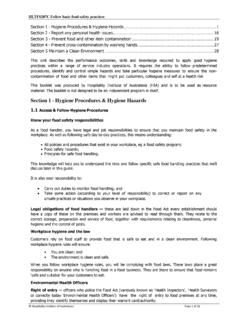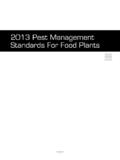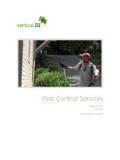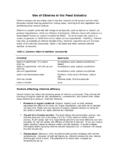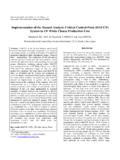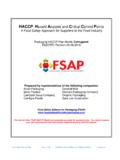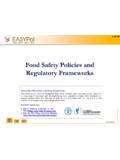Transcription of SITXOHS002A Follow workplace hygiene procedures
1 SITXOHS002A Follow workplace hygiene procedures Page 1 of 31 (c) Hospitality Institute of Australasia 2012 NRTATIONALLYECOGNISEDRAINING SITXOHS002A Follow workplace hygiene procedures Contents Section 1 - hygiene procedures & hygiene Hazards .. 2 Access & Follow hygiene procedures .. 2 Report Poor Organisation Practices .. 3 Identify hygiene Hazards .. 4 Take action to remove or minimise hazards .. 10 Promptly report hygiene hazards .. 18 Section 2 - Report any personal health issues .. 18 Report any personal health issues that are likely to cause a hygiene risk .. 18 Report incidents of food contamination that have resulted from the personal health issue 20 Section 3 - Prevent food and other item contamination.
2 20 Maintain clean clothes, wear required personal protective .. 20 Ensure that no clothing or other items worn contaminate food .. 21 Do not allow food to become contaminated from personal hygiene habits .. 22 Clean in manner to prevent cross contamination .. 23 Type of soil .. 27 Water Hardness .. 27 Section 4 - Prevent cross-contamination by washing hands .. 29 Wash hands at appropriate times .. 30 You can easily see dirt, but you can't easily see germs.. 30 How do germs get onto your hands? .. 30 How do you wash your hands?.. 30 Getting rid of most germs is simple - wash & dry your hands.. 30 Hand washing facilities .. 30 This unit describes the performance outcomes, skills and knowledge required to apply good hygiene practices within a range of service industry operations.
3 It requires the ability to Follow predetermined procedures , identify and control simple hazards and take particular hygiene measures to ensure the non-contamination of food and other items that might put customers, colleagues and self at a health risk This booklet was produced by Hospitality Institute of Australasia (HIA) and is to be used as resource material. The booklet is not designed to be an independent program in itself. Every effort has been made to ensure that this booklet is free from error or omissions. However, you should conduct your own enquiries and seek professional advice before relying on any fact, statement or matter contained in this book. Hospitality Institute of Australasia is not responsible SITXOHS002A Follow workplace hygiene procedures Page 2 of 31 (c) Hospitality Institute of Australasia 2012 for any injury, loss or damage as a result of material included or omitted from this course.
4 Information in this module is current at the time of publication. The time of publication is indicated in the date stamp at the bottom of each page. Section 1 - hygiene procedures & hygiene Hazards Access & Follow hygiene procedures Know your food safety responsibilities As a food handler, you have legal and job responsibilities to ensure that you maintain food safety in the workplace . As well as following safe day-to-day practices, this means understanding: All policies and procedures that exist in your workplace , eg a food safety program; food safety hazards; Principles for safe food handling. This knowledge will help you to understand the risks and Follow specific safe food handling practices that we ll discuss later in this guide.
5 It is also your responsibility to: Carry out duties to monitor food handling; and Take some action (according to your level of responsibility) to correct or report on any unsafe practices or situations you observe in your workplace . Legal obligations of food handlers these are laid down in the food Act every establishment should have a copy of these on the premises and workers are advised to read through them. They relate to the correct storage, preparation and service of food , together with requirements relating to cleanliness, personal hygiene and the control of pests. workplace hygiene and the law Customers rely on food staff to provide food that is safe to eat and in a clean environment.
6 Following workplace hygiene rules will ensure: You are clean; and The environment is clean and safe. When you Follow workplace hygiene rules, you will be complying with food laws. These laws place a great responsibility on anyone who is handling food in a food business. They are there to ensure that food remains safe and suitable for your customers to eat. Environmental Health Officers Right of entry officers who police the food Act (variously known as 'Health Inspectors', 'Health Surveyors or correctly today 'Environmental Health Officers') have the right of entry to food premises at any time, providing they identify themselves and display their warrant card/authority. Refusal to grant them admission is an offence and they are able to call police to assist them gaining entry: the moral of the story is simply to let them in when they arrive.
7 Power to inspect health officers have very great powers, and when you consider that part of their job is to protect public health, this stands to reason. SITXOHS002A Follow workplace hygiene procedures Page 3 of 31 (c) Hospitality Institute of Australasia 2012 They have a right to inspect any food premises (and beverages/liquor is deemed to be food ), its equipment and the food there. They have the power to take samples of whatever food they want, but they must pay for it, - offer the owner a sample of the same as the one they take, and take a third sample to act as a control in the case of dispute. Samples are analysed by a government agency to determine if they are in accordance with specifications.
8 Where a customer makes a complaint against a food premise, the health authority is obliged to investigate it. Where a food poisoning outbreak occurs, the health officers have the power to detain a person until they can obtain a faecal sample for examination. Inspection powers of health officers also cover the inspection of liquor with a view to assessing whether or not it has been contaminated or adulterated in any way ( , to check that liquor has not been watered down, and to check that one brand has not been substituted for another). food safety policies and procedures For all food businesses restaurant, retail food service, fast food , hospital, bistro or caterer food safety policies and procedures have become increasingly important.
9 food businesses must conform to legal requirements and ensure that food is free from contamination and will not cause a food poisoning incident. food poisoning outbreaks can have a devastating affect on a business, its staff and its customers. Sound food safety practices will identify food safety hazards, and reduce the likelihood of this occurring. What is a food safety program? A food safety program systematically identifies the food safety hazards that may reasonably be expected to occur in your workplace . It outlines the food safety procedures that must be followed to prevent, control and eliminate food safety hazards. It also documents how these procedures comply with food regulations and legislation.
10 A food safety program: Identifies where and how each hazard can be controlled; Describes how these controls are to be monitored; Describes the corrective action required if control conditions are not met; and Identifies records that must be kept. A food safety program must comply with relevant federal, state and industry legislation and regulations. While not required by law in NSW, food safety programs are being adopted in many businesses. Even without a formal food safety program, food safety procedures must be implemented to ensure legal compliance and ensure that all food produced for sale remains safe and suitable . Report Poor Organisation Practices Processes or practices that do not Follow the food safety program should be reported.
